Astronomers using the 1.2-meter Whipple Observatory to follow the brightness of a lensed galaxy for 14.5 years have calculated that the time delay between light arriving along the shortest and farthest paths is 6.73 years. Plus, DART, Hayabusa2, Juno, fast radio bursts, and This Week in Space History, we look back at NASA’s 1990s attempts to reach Mars.
Podcast
Listen on Libsyn (Now with podcast!)
Show Notes
DART to impact Dimorphos next week
- PDF: DART press kit (JHUAPL)
- VIDEO: The incredible adventures of the Hera mission – Creating a crater (ESA)
Juno spacecraft to fly close to Europa
- NASA JPL press release
Ryugu samples reveal asteroid’s origin story
- JAXA press release
- PSI press release
- “Formation and evolution of carbonaceous asteroid Ryugu: Direct evidence from returned samples,” T. Nakamura et al., 2022 September 22, Science
Quasar’s light echoes after 6.73 years
- University of Valencia press release
- “The Longest Delay: A 14.5 yr Campaign to Determine the Third Time Delay in the Lensing Cluster SDSS J1004+4112,” J. A. Muñoz et al., 2022 September 22, The Astrophysical Journal
- “A Mass Model for the Lensing Cluster SDSS J1004+4112: Constraints from the Third Time Delay,” R. Forés-Toribio et al., 2022 September 22, The Astrophysical Journal
1,873 Fast Radio Bursts from the FAST telescope
- UNLV press release
- “A fast radio burst source at a complex magnetized site in a barred galaxy,” H. Xu et al., 2022 September 21, Nature
This Week in Space History: Mars Observer
- “The Tragedy of Mars Observer,” Glenn E. Cunningham, 2017 July 7, IFAC Proceedings Volumes
Transcript
One of my favorite things about recent space missions is how various nations at various times have boinked, blasted, booped, and even tried to bury themselves in not-so-distant asteroids. I watched with great delight as Japan’s Hayabusa2 mission littered the asteroid Ryugu with tiny bouncy robots and then blasted it with what amounted to a very scientifically purposed anti-tank weapon to see what was beneath the surface.
In today’s episode, Erik discusses NASA’s plans to continue humanity’s space rock booping ways with the DART mission’s planned impact into the asteroid Didymos’ moon on September 26. We are in no danger unless impatience to get scientific results can kill us.
Along with discussing DART’s date with Didymoon, we also have some science from Hayabusa2, news from Juno at Jupiter, and some light-bending updates on the shape of space.
All this and more – like this week in space history – today, here on the Daily Space.
I am your host, Dr. Pamela Gay.
And we are here to put science in your brains.
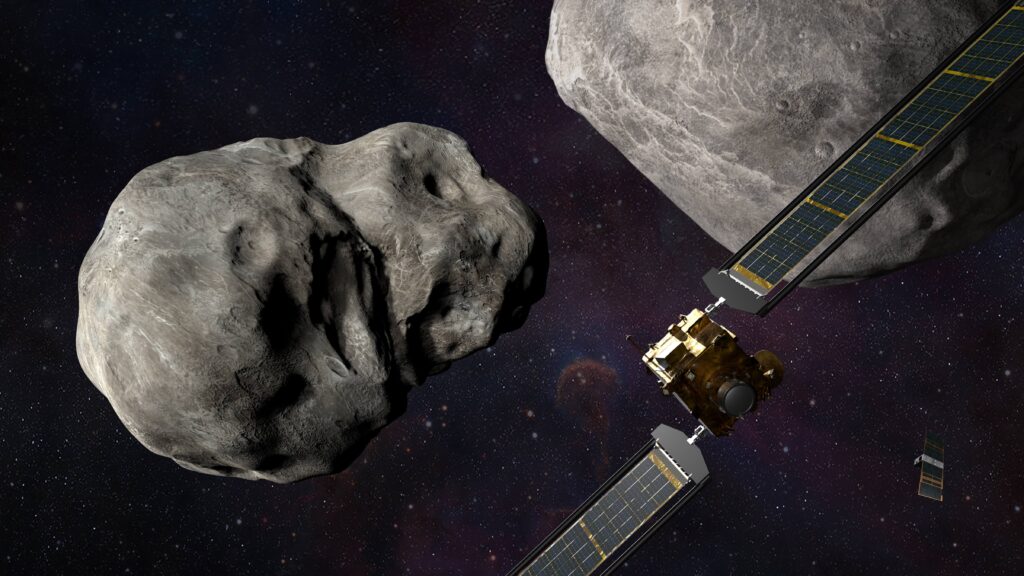
We’ve been talking about this mission many times recently, but here’s one final reminder. On September 26, the DART spacecraft will impact the moon of asteroid Didymos at 23:14 UTC. The goal of the mission is to change the orbit of that tiny moon, Dimorphos, by an incredibly small amount, essentially by launching the spacecraft directly at the moon like a small battering ram.
There are a lot of things the spacecraft needs to do before the impact. Four hours before impact, the autonomous navigation system activates. One hour before impact, tiny moonlet Dimorphos will become visibly separate from Didymos. Four minutes from impact, the autonomous navigation system begins its final correction, completed by two minutes to impact. Three seconds before impact, DART will take nine-centimeter per pixel imagery of the asteroid before hitting Dimorphos at over six kilometers a second relative velocity.
During and after the impact, DART’s companion CubeSat, LICIACube, deployed about two weeks ago, will be capturing images of the impact event. Then, in 2024, the European Space Agency plans to launch Hera, a spacecraft that will arrive in 2026 at the Didymos system, and take observations of both asteroids. Hera will be in the company of two CubeSats to take a complete survey, focusing especially on the impact crater left behind.
NASA’s official live coverage will start two hours before impact, and Beth Johnson will be co-hosting coverage for the SETI Institute with colleague Franck Marchis and a slate of guests involved with the mission. We’ll have links to all that coverage in the show notes for this episode.
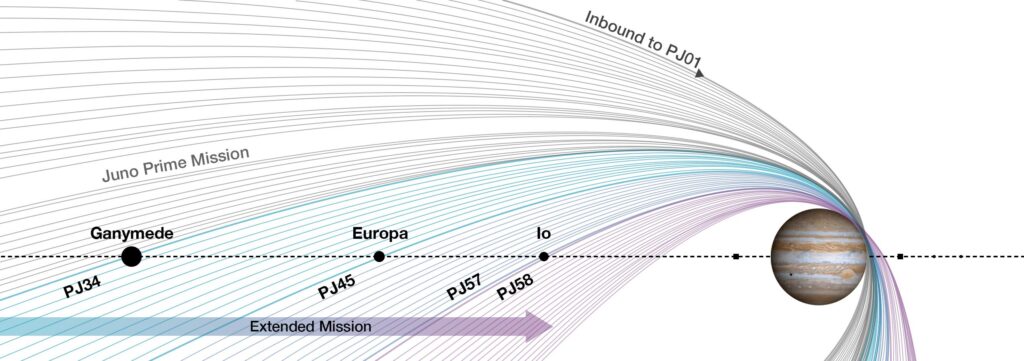
Also coming up next week, but with much less fanfare than the DART mission, NASA’s Juno spacecraft will make a close flyby of Jupiter’s moon Europa. The pass will happen on Thursday, September 29, at 10:36 UTC during perijove 45, or the 45th orbit of Jupiter. The closest approach to Europa will be about 358 kilometers, about as close as Galileo flew back in 2000. Deputy mission manager John Bordi notes: The relative velocity between spacecraft and moon will be 23.6 kilometers per second, so we are screaming by pretty fast.
One of the goals of this pass, which is taking place as a part of Juno’s extended mission, is to collect high-resolution images of the moon and collect data about the surface, the interior, and the ionosphere. Europa is important in the search for life beyond Earth, as evidence shows that under the thick icy surface is a salty, warm liquid ocean… that has the potential to support life. Two of the instruments on board Juno are specifically tasked with searching for possible water plumes erupting from Europa’s surface.
We’re hoping the mission has the right amount of luck necessary to capture that data along with what we’re sure will be amazing images. As always, we’ll bring you the results as soon as they are available.
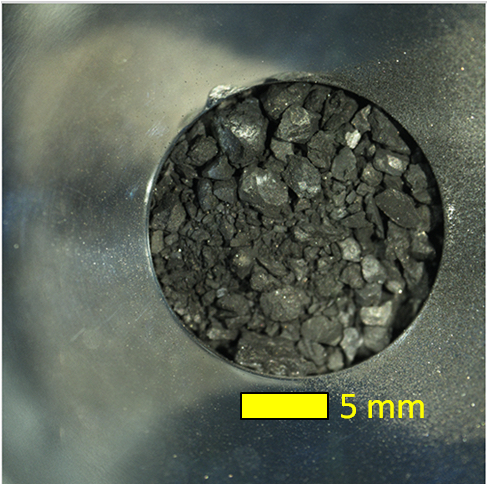
Also speaking of asteroids, back at the end of 2020, two samples collected by the Hayabusa2 spacecraft of the asteroid Ryugu arrived here on Earth. The samples were divided up among several space agencies, with the majority staying with JAXA since the mission was theirs. In exchange for sharing with NASA, JAXA will receive a percentage of the sample returning from asteroid Bennu and the OSIRIS-REx mission, which should arrive in 2023.
Now, in a new paper published in Science and led by Tomoki Nakamura, an analysis of seventeen grains finds that the parent body of Ryugu likely formed about two million years after the formation of the solar system. Co-author Deborah Domingue explains: The goal of these initial studies is to understand and characterize Ryugu’s formation history. While the orbital data identified the presence of phyllosilicates, it was an analysis of the samples that gave us information on the detailed mineral composition and the physical properties of the regolith grains.
The region where Ryugu’s parent body formed was extremely cold, contained both water and carbon dioxide as solids, and likely was as far away from the Sun as Jupiter is now, if not somewhat farther. That parent body was then broken apart by a massive impact, resulting in the formation of one of two known asteroid families. Ryugu was a part of one of those families and then migrated inward to what is now the asteroid belt.
Furthermore, Ryugu was far from the initial impact site, as none of the minerals found showed signs of shock features. And Ryugu was made from assorted fragments that came from different depths of the parent body, resulting in its intriguing mineral and chemical makeup… and rubble pile consistency.
All of that was learned by sampling tiny rock fragments and doing some numerical modeling. Science is awesome.
Coming up, how a time delay helps us understand dark matter and the galaxies clusters containing it.
Alright, it is time to leave behind the glorious science that is slamming spacecraft into space rocks and turn our attention instead to gravity’s great habit of bending light.
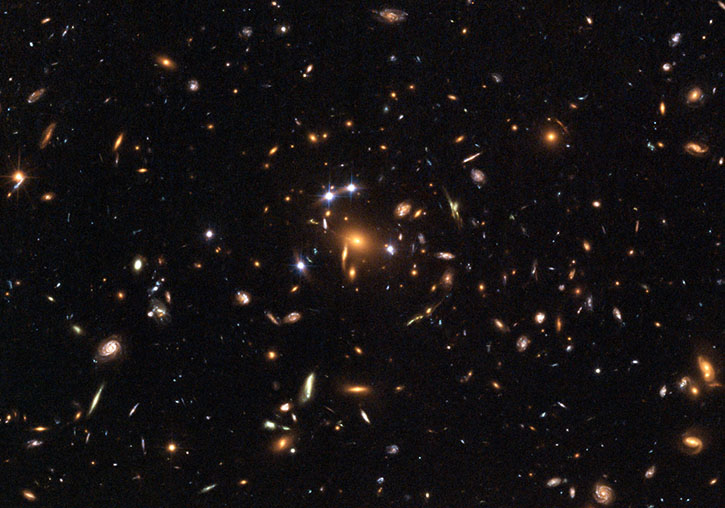
If you’ve been watching for a while, you know that gravity can act like a lens and direct light that might otherwise be headed to a different part of the universe toward us instead. Like a really badly made magnifying glass being used to focus the Sun’s light into a super bright blob on a sidewalk, this isn’t exactly a perfect process. Massive galaxy clusters, with their knots of material and large distribution of mass, actually have the ability to focus a single distant galaxy into multiple blobs of light. The wild thing is, the light from each of those blobs will have traveled a different distance as it shines from the source, passes some point in the cluster, and is then focused into place.
This has the somewhat wild consequence that since each blob comes from a different light path, we can simultaneously see distant galaxies at two points in their history.
This is because light travels at a finite speed. If one light path is 8 billion light-years long, and another is 7.999999999 billion light-years long, that tiny difference means we might see events, depending on how many nines are in there, anywhere from minutes to years apart in time.
Most galaxies are pretty placid, and while we might know we are seeing the same galaxy several different times as a galaxy cluster bends its light hither and yon, we will never know how different those light paths are if that galaxy doesn’t flicker or flare for some reason.
And astronomers eagerly watch for any change in brightness that might allow us to get this precious distance information.
We watch eagerly, and sometimes we watch for a really long time.
Researchers led by Jose A. Muñoz used the 1.2-meter Whipple Observatory to follow the brightness of a lensed galaxy for 14.5 years. This particular galaxy was split into four different images, with four different light paths. From this extraordinary run of observations, they were able to confirm that events seen in the lens with the shortest light path arrive almost seven years before the light arrives along the longest path.
Having seen the exact same events on repeat in these four different versions of the same galaxy’s light, astronomers now have the capacity to use these measurements to map out things like dark matter in the galaxy cluster responsible for all the light bending, and – with a whole lot of math that still needs to be published, and may still need to be done – researchers will also be able to use these repeating events to measure traits about our universe, including its expansion rate.
The time delay between light arriving along the shortest and farthest paths is 6.73 years. This is the longest known path distance of all gravitationally lensed objects so far studied. With that large difference will one day come great results. When they are published, we’ll bring them to you here on the Daily Space.
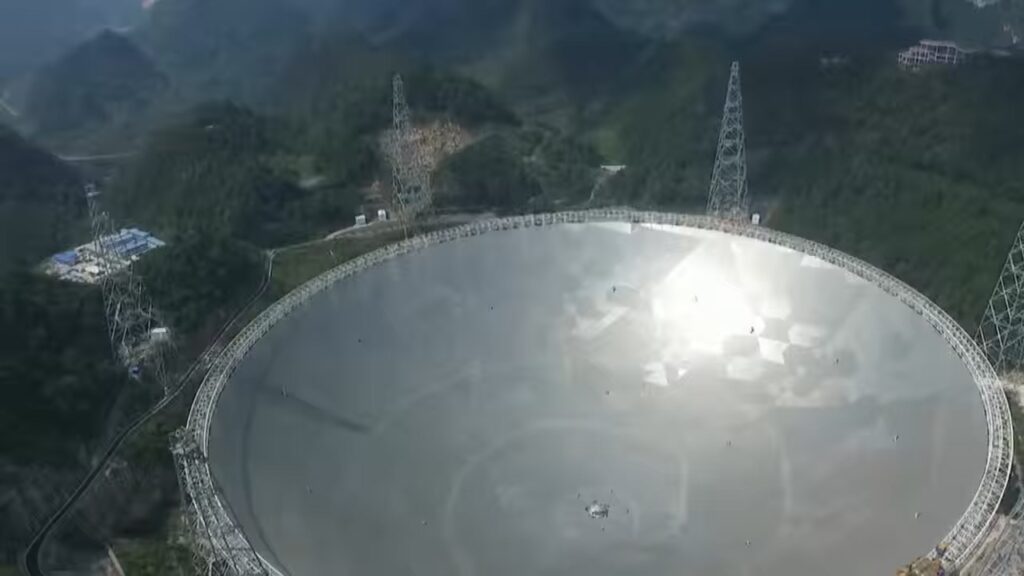
At a lot of different levels, the most interesting things in the sky are the things that vary in brightness. We see long and short period variations in every color and at every size scale. Our sky is active and constantly changing – we just can’t make out the majority of these changes with our eyes.
But telescopes can.
In the past decade, researchers using radio telescope data discovered a new kind of behavior. Sources somewhere out there have been shooting out massive amounts of radio light for very brief periods of time. Sometimes the events can occur in repeating clusters of the source being active and not active. Sometimes things have only been caught varying once. It is all a bit mysterious, and for lack of a better name for this mystery, these flashes have been called “fast radio bursts”.
In recent years many of these events have been linked to tiny but dense objects called magnetars. These objects are the remnants of once massive stars that have gone supernova and have left behind a neutron star in the process; a neutron star that, in some cases, ends up with a powerful magnetic field.
Unfortunately for astronomers, the universe often has more than one way to create an observable phenomenon.
1,863 bursts were discovered by China’s massive FAST radio dish in spring 2021. This is the largest sample set to date, and not all of these objects match what we’ve seen in the past. In fact, team member Bing Zhang states: These observations brought us back to the drawing board. It is clear that FRBs are more mysterious than what we have imagined.
The most distant sources they observed are totally mysterious, but they were able to see one relatively nearby system that stopped and started in ways we haven’t seen before. While they still seem consistent with a magnetar being at the heart of the emissions, what they saw doesn’t match the behavior of an isolated star.
This paper is published in Nature and led by the team of Heng Xu, Kejia Lee, and Subo Dong and raises more questions than it answers, but that is kind of awesome. The more questions we have to answer, the more reasons we have to do science.
Doing science is hard and some teams make it look easy. Coming up next Erik Madaus brings us a look at This Week in Space History and the struggle and triumph NASA has experienced getting missions to Mars.
This Week in Space History
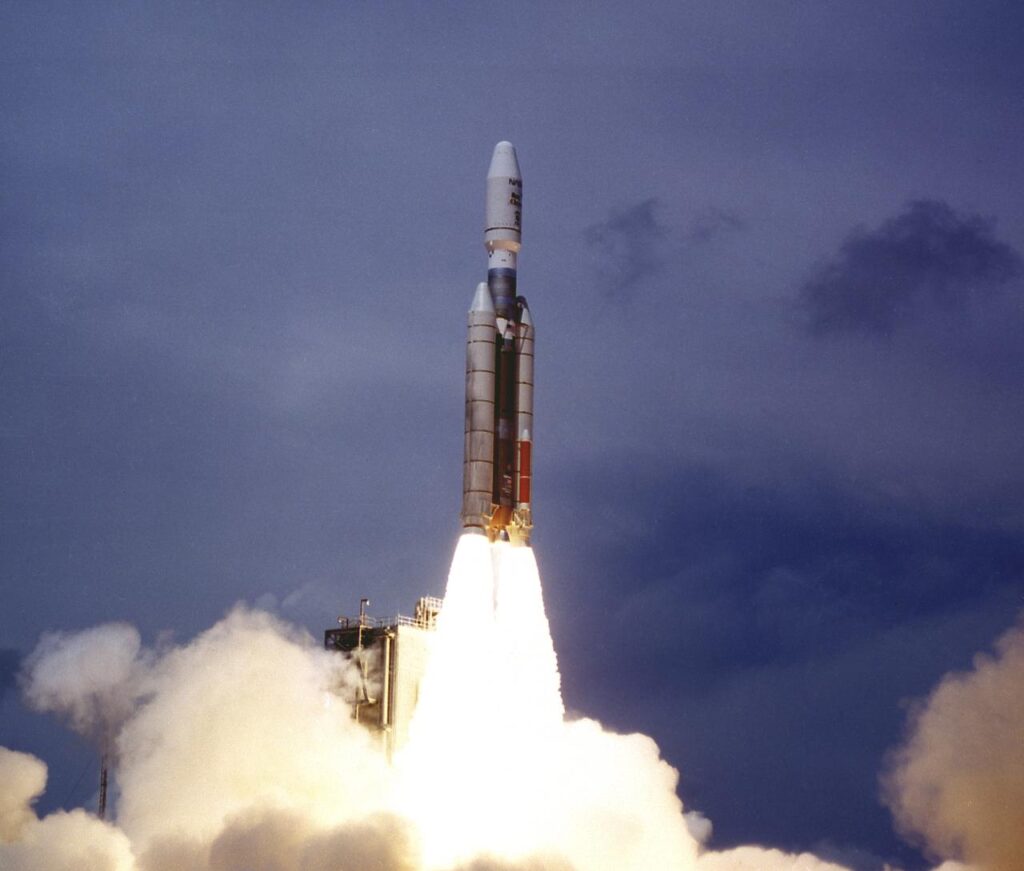
This week in space history: NASA’s Mars Observer.
Mars Observer started in the mid-1980s under NASA’s program of Faster Better Cheaper missions. Before Mars Observer, the last mission to Mars was Viking in 1976. The mission was designed in response to a decadal survey request for a small mission focused on Mars’ atmosphere and surface over a full Martian year.
Unfortunately, Observer ended up being neither faster, better nor cheaper. Instead, it ended up being one of many failed Mars missions NASA launched in the 90s.
The spacecraft was supposed to be basically off the same production line as a communications satellite going to geostationary Earth orbit. A key difference from NASA missions before or since is that the spacecraft was designed prior to the instruments – most science missions are designed the other way around. Another key change was the instruments themselves: they were supposed to be existing designs operated by experienced science teams.
However, none of those things ultimately happened, as a major imaging system was added late in the process, and the science instruments ultimately chosen had less “heritage” or knowledge on how they would perform and they would be operated by first-time investigators. This meant that the spacecraft had to be modified more than anticipated to accommodate these instruments. And the instruments brought with them a huge solar panel and a 1.5-meter diameter communication antenna.
Mars Observer was launched on a commercial rocket, the Commercial Titan III. The CT-3 was a version of the Titan 34D originally used to launch huge imaging satellites for the military.
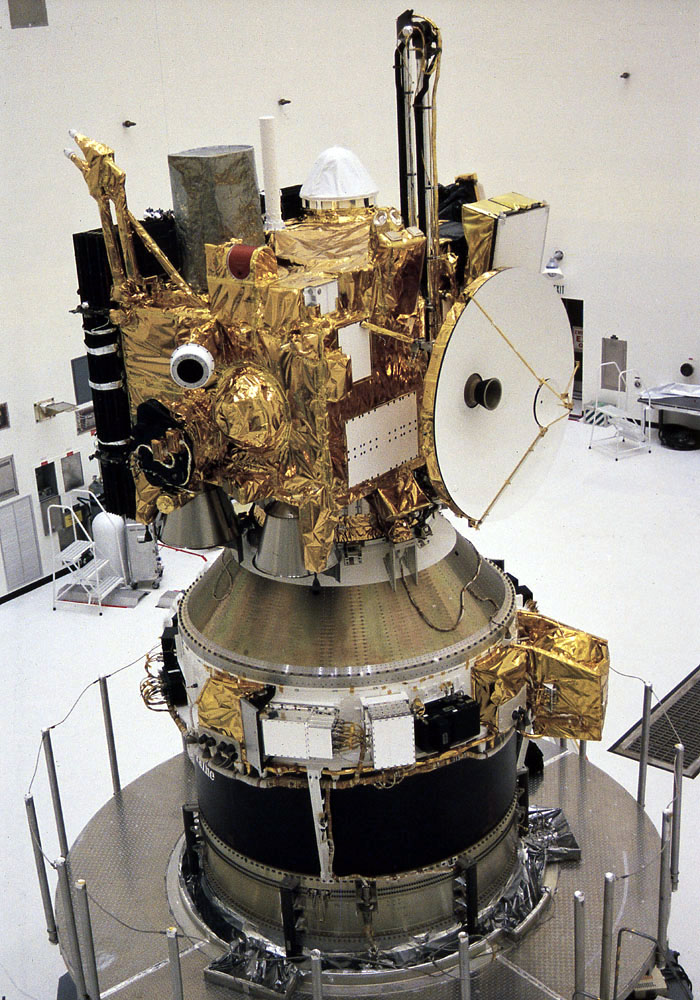
Mars Observer was launched on September 25, 1992, and by all accounts worked very well during its cruise to Mars, with only a few minor problems. It even took a few pictures of Mars about a month before it would perform its Mars orbit insertion. Three days before Mars orbit insertion, on August 22nd, 1993, contact with the spacecraft was lost. Despite three months of attempts, it was never re-established.
After attempts to regain contact were exhausted, NASA, JPL, and the spacecraft manufacturer each set up their own review boards.
None of the review boards came up with a definitive reason for the failure. The most probable cause was a leak in the fuel tanks during preparation for Mars orbit insertion that spun the spacecraft out of control and ripped it to pieces. According to the original plan, pressurization of the fuel tanks should have been done a month after launch, but it was moved to three days before insertion because of the risk of accidentally bursting the tanks before that point. The main engines were used before insertion but got their propellant via a different connection.
Mars Observer had a significant legacy despite its failure – it led to the more structured Mars Surveyor Program. Besides the technical lessons about spacecraft design and operation, NASA finally accepted that science spacecraft will never be cheap or mass-produced, and they need better risk assessments for projects as a whole.
The Mars Surveyor Program was a series of small missions launched during every possible launch window every 26 months. Both missions from the 1998 launch window failed, finally leading to the end of the Faster Better Cheaper program.
Duplicates of Mars Observer’s instruments were flown on the next orbiters NASA sent to Mars: Mars Global Surveyor, Mars Climate Orbiter (which also failed but for a different reason), Mars Odyssey, and Mars Reconnaissance Orbiter. Except for Mars Climate Orbiter, which never made it to Mars, and Mars Global Surveyor, which was retired after ten years, all are still in operation around Mars.
One last footnote, the launch of Mars Observer ended up being the final Commercial Titan III launch. Martin Marietta lost the government contract the rocket was designed for and it was more expensive than other commercial rockets at the time, so they only managed 4 launches. However, the rocket that did win that government contract to launch GPS satellites was McDonnell Douglas’s Delta II, which went on to launch many important payloads for NASA.
Statistics
And now, for some statistics.
The number of toilets in space is nine: four on the ISS, one on Soyuz MS-21, one on Soyuz MS-22, one on the Crew Dragon Freedom, one on Tianhe, and one on Shenzhou 14.
We keep track of orbital launches by launch site, also called spaceport. Here’s that breakdown:
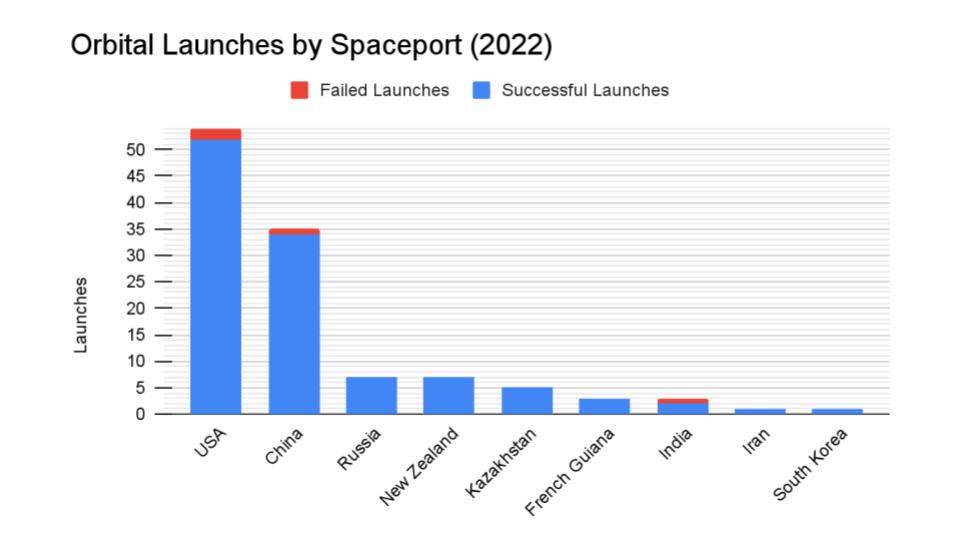
USA: 54
China: 35
Russia: 7
New Zealand: 6
Kazakhstan: 6
French Guiana: 3
India: 3
Iran: 1
South Korea: 1
From those 117 launches, a total of 1,827 spacecraft have been put into orbit in 2022, with 1404 of them being Starlinks, which is about seven out of every ten satellites launched so far this year.
Your random space fact for this week is that there were an odd number of four-segment shuttle booster launches. How did this happen? The last launch of a shuttle-derived vehicle from LC-39B was the Ares 1X test flight, which only used a single booster as its first stage. Ares 1’s design had a five-segment booster, but the 1X test flight had a dummy 5th segment.
This has been the Daily Space.
You can find more information on all our stories, including images, at DailySpace.org. As always, we’re here thanks to the donations of people like you. If you like our content, please consider joining our Patreon at Patreon.com/CosmoQuestX.
Credits
Written by Pamela Gay, Annie Wilson, Beth Johnson, Erik Madaus, and Gordon Dewis
Hosted by Pamela Gay, Beth Johnson, and Erik Madaus
Audio and Video Editing by Ally Pelphrey
Content Editing by Beth Johnson
Intro and Outro music by Kevin MacLeod, https://incompetech.com/music/


 We record most shows live, on Twitch. Follow us today to get alerts when we go live.
We record most shows live, on Twitch. Follow us today to get alerts when we go live.